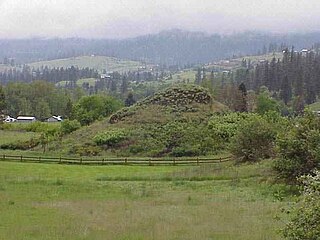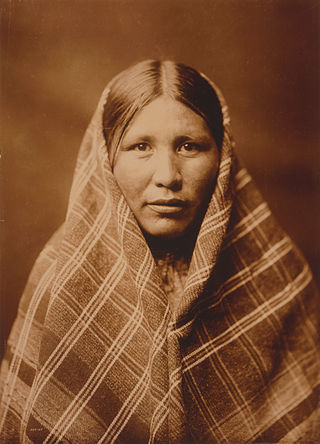
The Okanogan River is a tributary of the Columbia River, approximately 115 mi (185 km) long, in southern British Columbia and north central Washington. It drains a scenic plateau region called the Okanagan Country east of the Cascade Range and north and west of the Columbia, and also the Okanagan region of British Columbia. The Canadian portion of the river has been channelized since the mid-1950s.

The Colville Indian Reservation is an Indian reservation in the Northwestern United States, in north central Washington, inhabited and managed by the Confederated Tribes of the Colville Reservation, which are federally recognized.
The Confederated Tribes of the Colville Reservation is the federally recognized tribe that controls the Colville Indian Reservation, which is located in northeastern Washington, United States. It is the government for its people.

Indigenous peoples of the Northwest Plateau, also referred to by the phrase Indigenous peoples of the Plateau, and historically called the Plateau Indians are indigenous peoples of the Interior of British Columbia, Canada, and the non-coastal regions of the Northwestern United States.

Coyote is a mythological character common to many cultures of the Indigenous peoples of North America, based on the coyote animal. This character is usually male and is generally anthropomorphic, although he may have some coyote-like physical features such as fur, pointed ears, yellow eyes, a tail and blunt claws. The myths and legends which include Coyote vary widely from culture to culture.
Jeannette Christine Armstrong is a Canadian author, educator, artist, and activist. She was born and grew up on the Penticton Indian reserve in British Columbia's Okanagan Valley, and fluently speaks both the Syilx and English languages. Armstrong has lived on the Penticton Native Reserve for most of her life and has raised her two children there. In 2013, she was appointed Canada Research Chair in Okanagan Indigenous Knowledge and Philosophy.

The Sinixt are a First Nations People. The Sinixt are descended from Indigenous peoples who have lived primarily in what are today known as the West Kootenay region of British Columbia in Canada and the adjacent regions of Eastern Washington in the United States for at least 10,000 years. The Sinixt are of Salishan linguistic extraction, and speak their own dialect (snsəlxcín) of the Colville-Okanagan language.

Fort Okanogan was founded in 1811 on the confluence of the Okanogan and Columbia Rivers as a fur trade outpost. Originally built for John Jacob Astor’s Pacific Fur Company, it was the first American-owned settlement within Washington state, located in what is now Okanogan County. The North West Company, the PFC's primary competitor, purchased its assets and posts in 1813. In 1821 the North West Company was merged into Hudson's Bay Company, which took over operation of Fort Okanogan as part of its Columbia District. The fort was an important stop on the York Factory Express trade route to London via Hudson Bay.
The Interior Salish languages are one of the two main branches of the Salishan language family, the other being Coast Salish. It can be further divided into Northern and Southern subbranches. The first Interior Salish people encountered by American explorers were the Flathead people.

The Syilx people, also known as the Okanagan, Okanogan or Okinagan people, are a First Nations and Native American people whose traditional territory spans the Canada–US boundary in Washington state and British Columbia in the Okanagan Country region. They are part of the Interior Salish ethnological and linguistic grouping. The Syilx are closely related to the Spokan, Sinixt, Nez Perce, Pend Oreille, Secwepemc and Nlaka'pamux peoples of the same Northwest Plateau region.
Okanagan, or Colville-Okanagan, or Nsyilxcən, is a Salish language which arose among the Indigenous peoples of the southern Interior Plateau region based primarily in the Okanagan River Basin and the Columbia River Basin in precolonial times in Canada and the United States. Following British, American, and Canadian colonization during the 1800s and the subsequent assimilation of all Salishan tribes, the use of Colville-Okanagan declined drastically.
The Sanpoil are a Native American people of the U.S. state of Washington. They are one of the Salish peoples and are one of the twelve members of the Confederated Tribes of the Colville Reservation.

The Nespelem people belong to one of twelve aboriginal Confederated Tribes of the Colville Indian Reservation in eastern Washington. They lived primarily near the banks of the Nespelem River, an Upper Columbia River tributary, in an area now known as Nespelem, Washington, located on the Colville Indian Reservation. Alternate spellings include Nespelim or Nespilim.
The Colville people, are a Native American people of the Pacific Northwest. The name Colville comes from association with Fort Colville, named after Andrew Colvile of the Hudson's Bay Company. Okanagan: sx̌ʷyʔiɬpx) Earlier, outsiders often called them Scheulpi, Chualpay, or Swhy-ayl-puh; the French traders called them Les Chaudières in reference to Kettle Falls. The neighboring Coeur d'Alene called them Sqhwiyi̱'ɫpmsh and the Spokane knew them as Sxʷyelpetkʷ.
Debra Cecille Magpie Earling is a Native American novelist, and short story writer. She is a member of the Bitterroot Salish (tribe). She is the author of Perma Red and The Lost Journals of Sacajewea, which was on display at the Missoula Museum of Art in late 2011. Her work has also appeared in Ploughshares, the Northeast Indian Quarterly, and many anthologies.

The Salish peoples are indigenous peoples of the American and Canadian Pacific Northwest, identified by their use of the Salish languages which diversified out of Proto-Salish between 3,000 and 6,000 years ago.

Mary Alice Harriman was a poet, author and publisher. She was called the "only woman publisher in the world" in the 1911 Who's Who in the Northwest. She published books in Seattle between 1907 and 1910, and in New York after that, closing her publishing business in 1913.

Omak Rock, also known as Balance Rock, is a balancing rock in the Colville Indian Reservation, in the U.S. state of Washington. Located within the Greater Omak Area of the Okanogan Country, the glacial erratic is about 1,340 feet (410 m) from Omak Lake. It is positioned within the vicinity of the 1872 North Cascades earthquake, which it survived. The fact of its survival has been the basis of studies to help determine the acceleration and intensity of the quake. Some believe that the epicenter of the earthquake may have been very close to Omak Rock. The Confederated Tribes of the Colville Reservation believe that the rock represents a symbol of nature's perfection in the region.

Co=ge=we=a, The Half-Blood: A Depiction of the Great Montana Cattle Range is a 1927 Western romance novel by Mourning Dove, also known as Hum-Ishu-Ma, or Christine Quintasket. It is one of the earliest novels written by an indigenous woman from the Plateau region. The novel includes the first example of Native American literary criticism.

The Surrounded, D’Arcy McNickle's first book, was first published in 1936 by Harcourt, Brace and Company then republished in 1964 and again in 1978 by the University of New Mexico Press. McNickle was a Cree Métis author enrolled as Salish-Kootenai on the Flathead Indian Reservation.
















